1. About Psychographics
1.1. Our Psychographic Segments
1.3. Psychographics and the Segments on the Platform
1.4. Other Psychographics (Personality Traits)
1. About Psychographics
Based on psycholinguistic consumer modules of Symanto Psychology AI, further deep-learning clustering can be utilized for the identification of 360° consumer segmentation (Personality Traits Theory of Carl Gustav Jung’s Psychological Types are applied) to understand what influences the author’s decision-making process and preference.
Our psychographics allow you to break down your data by the available filter options and with these splits have a deeper look into psychographic-based segments to evaluate customer base value by combining customer personality and sentiment tonality.
1.1. Our Psychographic Segments
There are 4 different (plus 1 'Indistinct' = neutral Segment) psychographic-based segments: Loyalists, Ambassadors, Critics, and At-Risks. Each of them is defined by personality and sentiment tonality.

If you want to learn how to use the Psychographics module on the platform please click here: How to use the Psychographics
1.3. Psychographics and the Segments on the Platform
You can see a Pie Chart with the distribution of the Psychographic Segments in the tabs 'Classification', 'Sentiment Heatmap', 'Volume Comparison', 'Sentiment Distribution', and the Sentiment Analysis module. There you will be able to see psychographic elements when opening the sidebar to a specific topic
Example:
1.4. Other Psychographics (Personality Traits)
1.4.1. What are personality traits?
Personality traits are the building blocks of the person’s mindset which help to understand what influences the author’s decision-making process and preference.
1.4.2. Two rival dimensions
- A rational consumer tends to be analytical, critical, and pragmatic. They are detailed, weighing pros and cons, making comparisons with similar or competitor products/services.
- An emotional consumer tends to focus on emotions, making decisions based on personal values and beliefs. They also tend to consider the well-being of others, and how their decision affects both themselves and others.
 By predicting the personality traits, we can better understand if a person is objective and logical (rational) or empathic and relationship-oriented (emotional)… or of course, where in the middle they lie.
By predicting the personality traits, we can better understand if a person is objective and logical (rational) or empathic and relationship-oriented (emotional)… or of course, where in the middle they lie.
1.4.3. What is communication style?
We define communication style by two sets of polar dimensions: action - or information-seeking and fact-oriented or self-revealing. Together with personality style, these traits help define the consumer segment to target, develop truly resonating messaging platforms and guidelines for marcomm purposes, and more.
Communication style, once defined by the four characteristics, helps us detect the purpose of that text, which gives us a lot of valuable information about the author.
It’s important to remember that while the two sets of polar dimensions find themselves on extreme sides of the circle, it does not mean that people cannot represent a blend of both polarities. Let’s get into what each of these characteristics means.
1) Action Seeking vs. Information Seeking
Here we are referring to the communication details that a person uses in their communication, whether a social media post, a survey answer, a review, etc. We have seen that the communication details that a person uses in their own style of writing are often the preference for communication details that they themselves relate to best.
- Action seeking can be defined as writing in a manner that aims to trigger someone’s action be it by giving recommendations, giving advice, or making requests.
- Information seeking can be defined by someone who poses questions, who engages through questions. They communicate in a manner that actively, as the name entails, seeks information.
2) Fact-Oriented vs. Self-Revealing
When looking at this set of characteristics, fact-oriented versus self-revealing, we are looking at how a person forms their opinion and therefore expresses it. This is basically determined by what information a person chooses to describe their opinion.
- Fact-oriented content/posts are built using facts to describe their opinion about something.
- On the other hand, self-revealing-driven content/posts rely heavily on personal experience and opinion.
How do these differ? To better picture how these two dimensions, here’s an example of a bar review:
 Here we can see the first review text which is fact-oriented is much more based on facts whilst the self-revealing driven review text is based upon a personal experience and opinion of the customer.
Here we can see the first review text which is fact-oriented is much more based on facts whilst the self-revealing driven review text is based upon a personal experience and opinion of the customer.